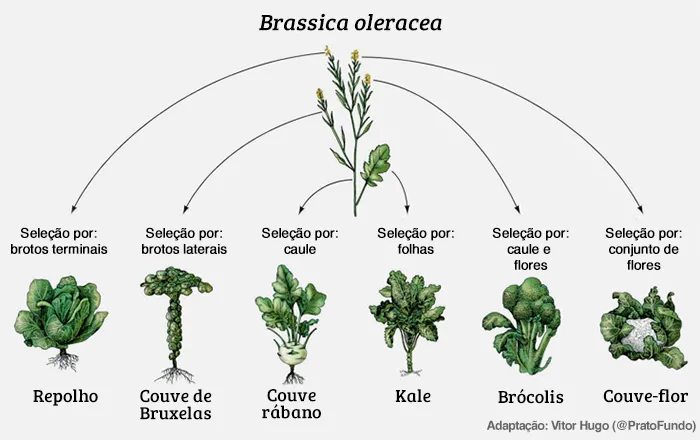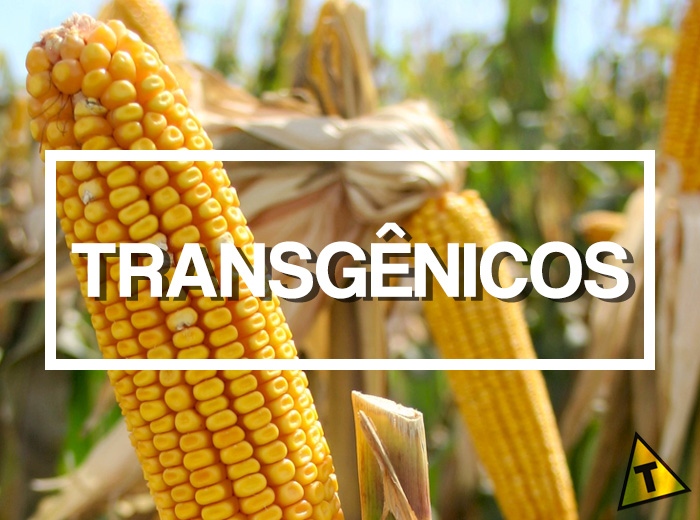The matter resurfaced with force in mid-April and May (2015) because of the approval of the bill (Law 4148/08 – Congressman Luis Carlos Heinze) to modify the labeling of products made with transgenic ingredients. This was in the Chamber of Deputies, but to enter into force it still needs to go through the Senate and be sanctioned by the Presidency.
So, very calm at this time! There are still steps until it is put into practice, if it is. Much has been said in this medium field, but as any controversial subject it is necessary to have the maximum information. As we well know, nothing is that simple and there are many shades of gray. And take the opportunity to drop these stones too.
But it is fair to ask: what are Genetically Modified Organisms?
Do you really know?
(Video: Jimmy Kimmel – What’s a GMO?)
I bring a video of Jimmy Kimmel that took the question to the streets… and the result is not surprising. The lack of information is glaring. It is a segment for TV. The production knows how to choose, but it is still an interesting sight. I think in Brazil it would be no different.
Legislation of GM food
In Brazil, the regulations have existed since 2005. If we tell the topic of labeling, it is older than 2003.
- Law No. 11.105/2005: establishes safety standards and mechanisms for the supervision of activities involving genetically modified organisms – GMOs and their derivatives, creates the National Biosafety Council – CNBS, restructuring the National Technical Commission of Biosafety – CTNB, provides for the National Biosafety Policy – GNP.
- Decree No. 5,591/2005: Regulates provisions of Law No. 11,105, of March 24, 2005, which regulates items II, IV and V of paragraph 1 of article. 225 of the Constitution, and gives other measures.
- Decree No. 6,041/2007: Establishes the Biotechnology Development Policy, creates the National Committee for Biotechnology and gives other measures.
- Law No. 11,460/2007: Provides for the planting of genetically modified organisms in protected areas.
Definitions of interest are present in law 11.105/2005 in article 3 dealing with what is organism, genetic engineering and genetically modified organism. For the purposes we have:
V – genetically modified organism – GMO : organism whose genetic material – DNA/RNA has been modified by any genetic engineering technique;
- Organism: any biological entity capable of reproducing or transferring genetic material, including viruses and other classes that may be known;
- Genetic engineering: production activity and manipulation of recombinant DNA/RNA molecules;
- Derived from GMOs: product obtained from GMOs and which does not have an autonomous replication capacity or does not contain a viable form of GMOs;
In the U.S. there are no specific laws for a modified body themselves, but guidelines for industry and consumers about products that have as an ingredient: Genetically Engineered Animals and Regulating Safety of GE Foods. So far it also does not require indication on the packaging, it only encourages the voluntary action of companies. Of course, there are regulations that target health, safety and environmental issues involving other American agencies such as the Department of Agriculture.
In the European Union, the legislation is stricter to release authorizations, it is done case-by-case based on facts. Responsibility is the responsibility of the European Food Safety Authority.
What is transgenic foods?
To facilitate understanding, the FDA (U.S. Food and Drug Administration) provides the following infographic:
The crossover of two species (usually of the same genus and/or species with different characteristics) to generate a third with the desired characteristic. The famous hybrid is a rustic example of the traditional method (in a very simple way). Much of the citrus fruits were produced in this way, naturally or artificially by human action.
If you’ve watched the Chef’s Table series, you’ve seen that chef Dan Barber works with Michael Mazourek (Geneticist for Plant Improvement at Cornell University) and created the Experimental 898 Pumpkin variety. A smaller fruit compared to the traditional version (butternut squash), focused on concentrating the taste of it. Transgenic? Probably not, but it is certainly a modified organism.
I believe that it is worth a caveat as to the terms Genetically Modified Organism (GMOs) and GMOs:
- Genetically Modified Organism (GMO): the genetic material of the organism has been modified either a rearrangement, withdrawal, duplication and the like. But without the addition of genetic material of different species.
- GM: there was the introduction of one or more specific genes (excerpt of genetic material) from a different species (kingdom, order, genus and the like).
Every GM is a Genetically Modified Organism, but not every genetically modified organism is a GM
Nowadays, with the advancement of technology it is possible to manipulate the genes present in the organism (usually plants). Connecting and turning off specific genes, and not at random as is the traditional crossover. The resulting vegetable (or other organism) is a modern genetically modified organism.
In the GMO it is to put, for example, a stretch of DNA of a fungus (different little) in a plant so that it becomes resistant to pests.
Bill 4148/08
The proposal in its text makes in fact the simplest Decree No. 4,680/2003 which is governed by Law No. 11,105/2005.
The project proposes: “limit of presence of GMOs (%) that exempts the labeling; prevalence of the criterion of detectability; and form of presentation of useful and clear information to the consumer”.
Technically, the question of informing the presence of GMOs and derivatives when it is above the 1% product limit has not changed. It still continues with this requirement as it is possible to read in the final newsroom.
What does not really exist is about the traditional symbol (triangle with central T) defined by Ordinance No.2.658/2003. The indication would change to a textual observation: “GMO’s name” or “contagin name” or “contagminant name” .
What I found particularly questionable is the loophole to use the term “GMO-free” for foods that do not contain “genetically modified organisms” by total proof of absence of genetically modified organisms, by means of specific analysis.
But as said, not being transgenic does not mean not being a genetically modified organism. Not to mention the marketing war this will generate, it will be the new “no cholesterol.”
Support the PlateFund
You help keep the site and videos on the air and we have very cool rewards, come to know how!
Genetic Improvement
It may not be the modern transgenic, but there has also been a genetic change.
Corn as an example. This one you just thought: a beautiful, very yellow ear, right? Can it be a transgenic as organs describe? Of course. Of course. But in essence it has always been a modified organism. – How?
Well, for the simple fact that the corn that we know does not exist in nature. He is a hybrid-mutant of two other basic plants (Zea mays parviglumis and Mexican Zea mays) and crossbreeding with other plants (Zea luxurians and Zea diploperennis). He came to this stage not because of a necessity of the plant for survival, but by human will. As astrophysicist Neil deGrasse Tyson says: it has undergone a forced evolution to meet us.
The same goes for other foods: chicken and livestock.
In the case of birds, many people believe that they grow so much by the use of hormones. No, it’s not used. For many factors: cost, management, sale and legislation. Practically the production and chickens is for export, and the buyer’s requirements are vast. If it is not within the established, the container is sent back without a mergi.
So what makes a chicken fit for slaughter around 30-40 days? Genetic improvement. The crossing of birds with desired characteristics. And improvement in the entire production chain, such as food.
(TED Talk: Christina Warinner – Debunking the paleo diet)
In the lecture on the “Paleolithic diet” (which yields another conversation) to Christina Warinner (doctorate in Anthropology; Archaeological Geneticist) comments how we manipulate what we eat, an example is the species Brassica oleracea (pule for 12m30s) that is ancestor of broccoli, cabbage, cabbage, kale and kale. All these vegetables are modern human creations. And such a Brassica is a wild plant.

Science
During the text research, a more appropriate TED Talk impossible was published. Explanation of Pamela Ronald, PhD Professor in Pathology and Plant Genetics at the University of California.
(TED Talk: Pamela Ronald – The case for engineering our food)
The work of Dr. Pamela is amazing and shows the other side of the coin, small farmers also benefit from the development of resistant plants. If you haven’t seen it, a spoiler: her husband is an organic farmer.
After attending the lecture some may consider that the teacher has sponsorship of large companies. The costing itself is not the problem, but the possible conflict of interest if the results are contrary to what the sponsor wants. What is a legitimate suspicion, unfortunately, happened and happens in which scientists forget their role in science.
In the most recent articles, financial support were from the U.S. government itself (energy department and agriculture) and other research institutes. What is common in the middle. In time, usually in articles published somewhere is reported as thanks to this type of support.
Another detail, the subject focuses only on food. However, GMOs impact other areas also such as medical and energy. Currently, the insulin used by diabetic patients is produced by fungi (Saccharomyces cerevisiae, bread and beer yeast) and bacteria (Escherichia coli, yes a type of fecal coliform) genetically modified to generate the hormone. Energy is in the production of alcohol, improve the fermentative capacity to increase yield.
Are GM foods dangerous?
The evidence indicates that they are not, if it is to bet, I believe not. Considering human history in relation to all the living beings we manipulate in our favor.
If you are the case to choose a side, do it on fact and do not ship. Gastronomy is already full of myths and lack of knowledge, there is no need for another one. Look for information (Greenpeace and Monsanto are not reliable sources, okay?), read scientific articles, talk to researchers, geneticists, do your homework and more that dose of common sense.
And remember: Science is neutral, it is misrepresented by human action.
One certainty is: one way or another, modified organisms are part of our diet and life. And they always will. Whether you like it or not.
Bibliography
- Brazil : Law No. 11.105/2005: Regulates items II, IV and V of paragraph 1 of art. 225 of the Federal Constitution, establishes safety standards and mechanisms for monitoring activities involving genetically modified organisms – GMOs and their derivatives, creates the National Biosafety Council – CNBS, restructures the National Commission of Biosafety – CTNBio, provides for the National Policy of Biosafety – GNP, repeals Law No. 8,974 of January 5, 1995, and Provisional Measure No. 2,191-9, of August 23, 2001. 5th, 6th, 7th, 8th, 9th, 10th and 16th of Law No. 10,814, of December 15, 2003, and gives other measures
- Brazil : Decree No. 5,591/2005: Regulates provisions of Law No. 11,105, of March 24, 2005, which regulates items II, IV and V of paragraph 1 of art. 225 of the Constitution, and gives other measures
- Brazil : Decree No. 6,041/2007: Institute the Biotechnology Development Policy, creates the National Committee of Biotechnology and provides other measures
- Brazil: Law No. 11,460/2007: Provides for the planting of genetically modified organisms in conservation units; adds provisions to Law No. 9,985, of July 18, 2000, and to Law No. 11,105, of March 24, 2005; Repeal of Law No. 10,814, of December 15, 2003; and gives other measures
- Brazil : Decree No. 4,680/2003: Regulates the right to information, provided by Law No. 8,078, of September 11, 1990, in respect of foods and food ingredients intended for human consumption or animal that contain or are produced from genetically modified organisms, without prejudice to compliance with other applicable rules
- Brazil : Ordinance No. 2,658/2003: Defines the symbol of art. 2nd, paragraph 1, of Decree 4,680 of April 24, 2003
- MAP: Animal Genetic Improvement
- EMBRAPA : Animal genetic improvement in Brazil fundamentals, history and importance
- EMBRAPA : Embrapa Agency for Technological Information: Genetic Improvement
- FDA : Genetically Engineered Animals
- FDA : Regulating Safety of GE Foods
- NSF: Scientists Trace Corn Ancestry from Ancient Grass to Modern Crop
- The Library of Congress : Restrictions on Genetically Modified Organisms: United States
- University of Utah: Genetic Science Learning Center: The Evolution of Corn
- European Union : European Food Safety Authority
- MATSUOKA, Yoshihiro et al. A Single Domestication for Maize Shown by multilocus microsatellite genotyping. Proceedings of the National Academy of Sciences of the United States of America, 2002.

Sign up for our newsletter and stay up to date with exclusive news
that can transform your routine!
Warning: Undefined array key "title" in /home/storelat/public_html/wp-content/plugins/link-whisper-premium/templates/frontend/related-posts.php on line 12
Warning: Undefined array key "title_tag" in /home/storelat/public_html/wp-content/plugins/link-whisper-premium/templates/frontend/related-posts.php on line 13




